June 11, 2004
23°49.8’S, 151°14.62E
Gladstone Marina, Queensland, Australia
Cruising the Curtis Coast
By Lois Joy
June 11, 2004
23°49.8’S, 151°14.62E
Gladstone Marina, Queensland, Australia
Cruising the Curtis Coast
By Lois Joy
Friday at 0635: The golden globe of sun brashly breaks from the the horizon,
a bulwark of stones lining the marina basin. We are in Gladstone, having arrived
here yesterday after cruising the coast for about 100 nautical miles over
the past three days. Our ‘Bible’ for cruising this area, Noel
Patrick’s CURTIS COAST, calls Gladstone “a modern pretty city
offering top facilities and amenities.” The residents of Bundaberg to
the south, proud of their charming river town, call Gladstone “an ugly
industrial port city,” adding, “you would only want to go there
to obtain supplies.”
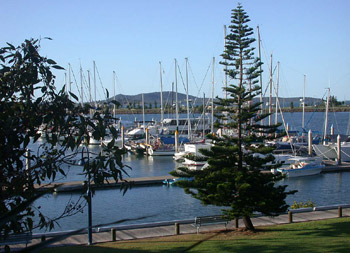
Last night, we took a twilight walk along the well-kept marina’s boardwalk, then followed the cobblestone sidewalk fringed with green manicured grass across the bridge, past the modern Queensland University campus and over to the Curtis Yacht Club along the wharf. At the Club, we enjoyed the comraderie of the family belonging to Shoreline Song, an Aussie yacht we had first encountered in Vanuatu. We ordered one serving of ‘pasta seafood marinara’ and garlic bread to share. We couldn’t finish the bowl of pasta heaped with a lobster, mussels, and shrimp. “I can’t believe that one person can finish this,” I said as I shoved my chair back from the long wooden table and prepared to walk back to the marina.
“I’ve seen one of those workers from the docks scoff up the entire bowlful easily,” John assured me.
The Lonely Planet calls Gladstone (population 27,400) one of the busiest
ports in Australia, handling agricultural, mineral and coal exports from central
Queensland: “Scenically challenged industrial plants mar the town’s
otherwise attractive estuary setting.” It goes on to say that there
are a few things here to interest ‘diligent visitors.’ Most of
what it says to do is right here at the marina: an overlook to the harbor,
shipping terminals, and yachts. No wonder the Vistors’ Bureau is located
in the Marina Complex! 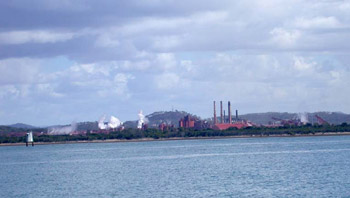
Apparently, this is one of those cities where arriving by yacht is the preferable alternative. After we had taken down the sails on Pacific Bliss and turned to follow the buoys marking the shipping lane, we motored another 16 miles over a flat sea reminiscent of old-fashioned bottle glass. Diligently following the rules of the road, the red buoys on the left and green on the right, and keeping to the right of the imaginary middle line, we ticked off the miles along ‘the teal highway.’ We passed smokestacks, storage towers, shipping terminals, cranes, and mountains of red bauxite being loaded onto waiting ships.
Yesterday our voyage from Pancake Creek could not have been better. We rose with the sun, brilliant in the cloudless sky over Clew Point. By 0800, we had hauled anchor and were underway, the chords of Amazing Grace radiating from the cockpit speakers. We had successfully navigated the shifting river bed out of Pancake Creek, winding back and forth between the markers, backtracking along our incoming path on CMAP, our electronic chart. As we went out to sea, we looked back at “our” Lighthouse, bathed in the ethereal morning light at the top of Bustard Head. It seemed to stand there, stalwart yet forlorn, taking on human characteristics because we had now become familiar with its colorful past: it is called ‘The Lighthouse of Tragedy.’ But that’s a different story I plan to post in the Yarns and Characters section of this website.
After we reached a 50’ depth, we turned into the wind, raised our mainsail,
then set a straight-line course to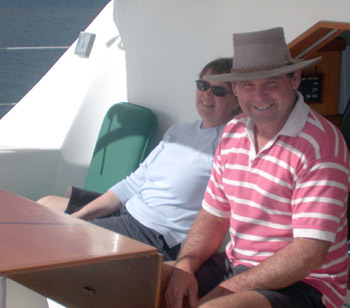 the first buoys of the Gladstone shipping channel, 16.3 miles away. The wind
was at our back, at an ideal 15-18 knots ESE, the skies clear, the swell benign,
and the seas following. How much better could it get? It was an ideal voyage
for our new-found mates, Kate and Graham, who joined us at Bundaberg. They
are sugar farmers who had met us through our website and shared with us their
dreams about retiring and owning a Catana Catamaran. We invited them on board
for our little excursion up the coast. As they left us at Gladstone, Kate
called out, “Keep that website updated now!” I will do my best
Kate, and may your dreams come true!
the first buoys of the Gladstone shipping channel, 16.3 miles away. The wind
was at our back, at an ideal 15-18 knots ESE, the skies clear, the swell benign,
and the seas following. How much better could it get? It was an ideal voyage
for our new-found mates, Kate and Graham, who joined us at Bundaberg. They
are sugar farmers who had met us through our website and shared with us their
dreams about retiring and owning a Catana Catamaran. We invited them on board
for our little excursion up the coast. As they left us at Gladstone, Kate
called out, “Keep that website updated now!” I will do my best
Kate, and may your dreams come true!
But back to the beginning:
˜
Anchored at 24°10.2S, 151°55.2E, Round Hill Creek
We left Port Bundaberg on Tuesday morning at 0620. Coming out to sea from the Port Marina was rather rough, with a two-meter swell. After we turned north up the coast, we had a nice 6 ½ hour sail: wing-on-wing at 6-7 knots, the wind SE at 16-18 knots, with following seas. Gunter and I were exhilarated; it was the first time we had been under sail in 2004. Kate was seasick at first, but by the time we arrived she had gained her sea legs.
Pacific Bliss surfed and broached over the tricky sand bar entrance at Round
Hill Creek, as Captain Gunter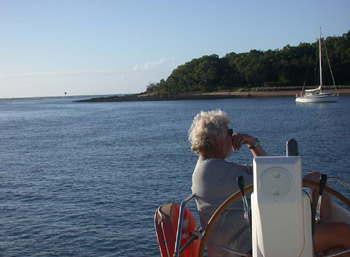 quickly gunned the engines. Then we slowly wound through the shifting creek
bed, dropping anchor at a 6’ depth at 1500 (3 PM), just 8 minutes before
Venus would begin her transit across the face of the sun. I retrieved the
two shades our friend Richard had thoughtfully sent along with us and cut
each in two—one for each of the four sailors on board.
quickly gunned the engines. Then we slowly wound through the shifting creek
bed, dropping anchor at a 6’ depth at 1500 (3 PM), just 8 minutes before
Venus would begin her transit across the face of the sun. I retrieved the
two shades our friend Richard had thoughtfully sent along with us and cut
each in two—one for each of the four sailors on board.
I held the square shade up to the sun like a pirate with an eyepatch. “I see a notch in the sun at one o’clock, that must be it,” I said.
“So do I,” said Graham, perched at the edge of the cockpit, peering through one eye.
“I don’t see a thing,” said Gunter. “I think you’re imagining it.”
“Just like you thought I imagined the green flash until you finally saw it yourself in the South Pacific,” I retorted. “No one alive today saw the last transit and you won’t see another one until 2012 if you miss this one.”
It was at least an hour before we could all see Venus as a black ball separated from the golden rim of the sun. Two hours later, when the sun was low on the horizon, we could see Venus better yet, crossing the top of the sun toward eleven o’clock. It looked as if the sun had one skewed, black eye. It was wondrous to witness an event that is visible only twice every century or so.
Thanks, Richard! Too bad you couldn’t see it too, since it was nighttime in California.
The sun did not lose one iota of its brilliance. Later, I found out why.
Venus, with a diameter one thirty-second of the Sun's, will cause a one-tenth
of 1 percent drop in
sunlight that reaches Earth.
After the mini-eclipse, I again thought of my hero, Captain Cook, who came ashore in these parts. In fact, we were now anchored in the waterway along the Town of Seventeen Seventy. (See related story, The Town that Wasn’t). We could see visitors with sunshades lining the banks of the Caravan Park to watch the event. Wasn’t his voyage to Australia the same one on which he was charged with sailing to research this event?
Yes, indeed. It turns out that the British Crown, not wanting to be left behind in the quest for scientific discovery, agreed to pay the expenses of an expedition to observe the once-in-a-lifetime astronomic occurrence from Tahiti. They wanted to relate southern hemisphere observations to those made in various northern hemisphere locations to help determine the distance of the earth from the sun. The Admiralty was to provide the ship and guess who got the job? Captain Cook, of course. The ship was the 368-ton Endeavour Bark. After making observations of Venus in Tahiti, Cook was to proceed to latitude 40° South to try to find the supposed great southern continent. He left Plymouth in August 1768.
Cook—along with others--was frustrated because he couldn’t time
the exact moment when the edges of the planet and the Sun appeared to touch.
When Venus nears the edge of the disc of the Sun, its black circle appears
to ooze toward the edge of the sun without showing a clear point of contact—just
as we observed.
Although the precise second of contact was needed for calculations, this so-called
"black drop" phenomenon caused observers back in 1769 watching the
same event to disagree by several seconds up to a minute on when the outer
edges touched. Cook and other observers speculated that the problem was the
distortion of light through the Venusian atmosphere.
The last transit of Venus was in 1882. It inspired an international effort to use the event to answer one of the most pressing scientific questions of the day: What is the exact distance between the Sun and Earth? According to the New York Times website, “Although studies of the event failed to provide an exact answer, they did narrow the range of estimates and measurements, and ushered in an era of investing in science as a symbol of national prestige. For the last event, the United States government mustered eight expeditions to make observations around the world, partly because Britain, France, Russia and other rivals did the same.”
The question was answered in the 1960’s. By bouncing radar signals
off the Sun and Venus and using spacecraft measurements, scientists calculated
that the average Sun-to-Earth distance is 92,955,859 miles, a measure now
called the astronomical unit.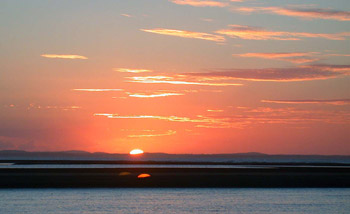
˜ After the sun set over the myriad rivers and sand dunes making up the Pancake Creek estuary, I made Indian-spiced Tikka Chicken Marsala with a simmer sauce I purchased at Cole’s in Bnndy—as tasty as that of our own Trader Joe’s brand—served over fettucine. We ate in the cockpit by candlelight as the Milky Way flooded the night sky. Our dinner conversation was about life in the Outback. Kate had lived in Darwin as a child.
“Crocodile Steve is just a showman,” said Kate. (Listen up, grandchildren!) “You can find the real thing in the Northern Territories.”
“These guys know no fear,” added Graham. Ron F is one I know of. He understands crocs and snakes and has the proper amount of fear. Crocs used to be protected. Now there’s enough in the Northern Territories that they are planning to have big game hunters come in to hunt for sport.”
“Are there crocs right here, where we’re anchored?” asked Gunter.
“Could be. Don’t ever swim at night. From here north.”
“In the book I’m reading, it talks about how they hunted crocs right here for Sunday afternoon sport,” I said.
“Well, you know how the jackeroos tell if there’s a croc around?”
asked Graham.
“How?” asked Gunter.
“They might look around their station and say, ‘Must be a croc around, used to have aronnd 30 dogs, there seems to be only 10 or so here now.’ ”
“I know one bloke named Tevvy; he’d shoot all kinds of critters right from his helicopter,” Graham began. “They caught him for crabbing from his helicopter. They knew it was him because his helicopter was bright pink. One day Tevvy had left his engines on with the blades swirling around, as usual, while he checked a fence. Going back to his helicopter, he forgot to duck. The blades cut his head off.”
“A tough life,” commented Gunter.
“Well, the pilots, who traveled alone to check fences and so on, and they always had a carton of beer on board and who knows how many before. By the way, it always good to have a carton of beer handy if you’re counting on help in the outback. VB, Victoria Bitter, is good. Those blokes will do anything to help someone out, but it always costs a carton of beer. And it must be consumed straight-away.”
“Can you give me examples?” I asked.
“A flat tire, or an auto breakdown…being bogged in the mud. They could spend $200 flying back to get parts to help you out. But it always costs you a carton.”
“Wouldn’t they get flat out drunk?” I asked.
“No,” Kate answered. “It’s so hot up there in the Northern Territory, it just comes right out of their pores in sweat.”
“And when you say ‘Thanks’ you never ask a bloke his name, added Graham. “It’s rude. He may have a history. Just call him mate.”
I turned on the nav instruments before turning in for the night. The depth showed 1.4 feet. There would be no swimming (or walking) in the creek tonight. A simple wash-up would do just fine!
˜
Anchored at 24°01.4S, 151°44.34E, Pancake Creek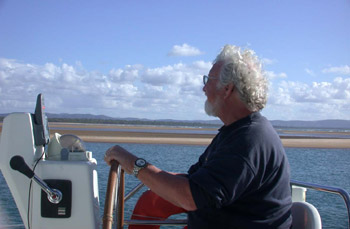
The sand bar at the entrance here wasn’t as difficult as the one we had to overcome entering and exiting Round Hill Creek. But winding around the red and green markers to exit was not easy. We all missed a red buoy, looking black in the sun. Our port daggerboard touched sand and we sharpened the prop a little as Gunter backed off and I corrected our course. We had another pleasant sail with following seas under mostly-clear skies.
At midmorning and also mid-afternoon, it is ‘smoko’ time in Queensland.
We always had plenty to choose from--Kate had brought so many goodies--quiche,
Bundy sugar syrup with a molasses taste, double chocolate cookies, home-made
Tall House cookies, and of course, the omnipresent Vegemite. At 1000, my mates
had syrup sandwiches; I settled for half of a chocolate cookie filled with
chocolate frosting. We’d need a lot of hiking shoreside to overcome
these ‘smokos.’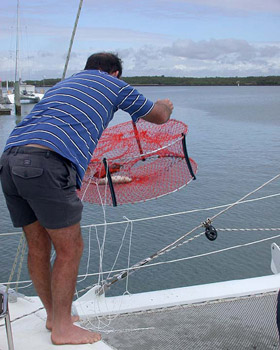
By early afternoon, we had dropped anchor in Pancake Creek after an easy three-hour sail. Graham and Gunter added our frozen mullet to the Crab Pot and it went down next. Then it was time to eat again. By the time we put the dinghy down and went ashore to hike toward Bustard Lighthouse, it was already 0400. (I’ll save that hike for another story so that I can post this story today.)
I’m always curious about how places get their names. I am assuming that Agnes Water was named after the ship Agnes that sunk after leaving Pancake Creek June 16, 1873 heading into ‘very dirty weather,’ increasing to gale force. The 66-ton schooner was never seen again. And no traces of the 12 passengers headed for Brisbane were ever found.
Pancake Creek had originally been named Frying Pan Creek and no-one knows why the name changed. It is known, however, that the cutter ‘Pancake’ traded along the coast in that area, skippered by a man known as ‘Pancake Dick.’ I continued to read about the history of the area until I drifted off to dreamland that night.
|
|
 |
 |
 |
|
|||||||||
|
|
|
||||||||||||
|
|
|
||||||||||||
|
|
|
||||||||||||
|
|
|
|
|
|
|
|
|
|
|||||
|
|
|
||||||||||||
|
|
|
||||||||||||
 |
 |
|
|||||||||||
|
|
|
||||||||||||
|
|
|
||||||||||||
|
|
|
||||||||||||
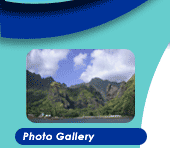 |
|
||||||||||||
|
|
|
||||||||||||
|
|
 |
|
|||||||||||
 |
|
||||||||||||
 |
|
||||||||||||
 |
|
||||||||||||
 |
|
||||||||||||
 |
|
||||||||||||
|
|
|
|
|
|
|
|
|
|
|
|
|
|
|